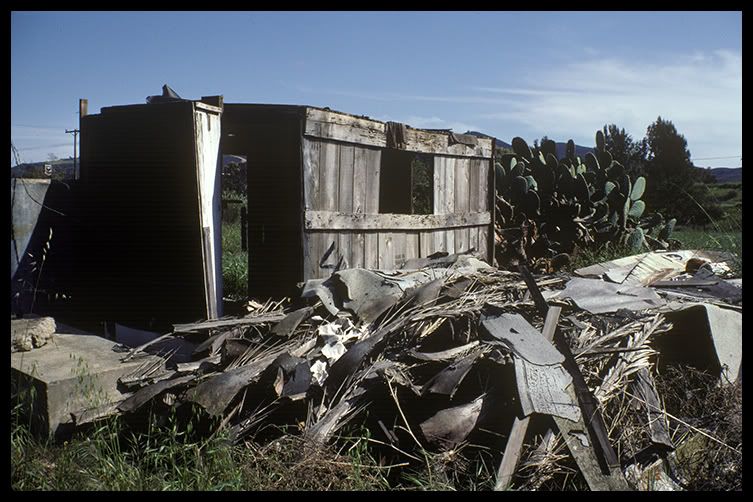
California, An Endangered Species.

The past and the present. I was born at this location in San Marcos (San Diego County), California in 1956. Ten or fifteen years ago I could have found my way here nearly blindfolded. I had to really search for it this time–nearly all recognizable landmarks are gone. Quiet country living has given way to a freeway and strip malls.

Sam Soderberg and neighbor friend.
During the first half of the twentieth century there was what could be called a romance of California living. Frank Lloyd Wright once used the term California Romanza. City life was in a patchwork of what are called urban villages. Both San Diego and Los Angeles had a grid of metropolitan trolley lines. Planners in those days built many bungalows and bungalow courts along these trolley lines. In San Diego of 1947 you paid a nickel to ride anywhere among the urban villages. Downtown, North Park, Kensington, Normal Heights, Hillcrest, Mission Hills, University Heights were among the familiar names along the way. Many dwellings came without garages–it was typical for many to get around without an automobile.
But city living was only one option when living the California Romanza. There was also the country life. Quiet, wide open spaces and fresh air. San Marcos of 1956 was a part of a much more expansive patchwork of areas perhaps too sparsely populated to be called villages. You really only became aware of entering San Marcos because of a cluster of signs indicating the agricultural organizations of the area. The chicken population of San Marcos was vastly greater than the human population.

Gone are the picket fences, the old farm houses, chicken ranches, and livestock. Echo Lane, which was then a dirt road (It washed out during wet years) is now a drive way into the parking lot for big box retailers including Home Depot.

The sign at the edge of the property read “Echo Lane Kennels.” My mom and dad raised beagles and won a shelf full of trophies and ribbons from dog shows. We had this horse for a short time. It was a temperamental creature that liked to throw its rider and kick.

Not a horse friendly sight now. The parking lot and architecture could really be anywhere. All across the country there are countless such developments. A homogeneous strip mall model has cookie-cut its way from one end of the country to the other. The landscaping here falls into a term commonly used: “mitigation.” When enough people decry the ugliness of a development, a few bushes and trees are added to “mitigate” the impact.

These were the “star” breeders for Echo Lane Kennels, Marilyn and Joe–named after Marilyn Monroe and Joe DiMaggio. These two beagles produced many a prize winning offspring.

Sam and Zack Soderberg
And there were sheep. A child’s life centered around household animals and livestock on several acres of land can only be found in California nowadays in areas far more remote than San Marcos. Once just a dot on the map, San Marcos today is joined at the hip with Escondido as a mini megalopolis.

No longer a place where “the sheep and the antelope play.” One of the reasons so many of us “old timers” got involved with the effort to save Trestles and San Onofre State Park is because we have witnessed the huge change in California in our life time. The creation of the California Coastal Commission was largely the result of a realization that California was being lost to development. Having this commission was a figurative drawing of a line in the sand. We’ve pretty much lost the interior of California to freeways, subdivisions and strip malls. The country life of communities such as San Marcos is gone forever. But the creation of the Coastal Commission was to say “hands off” when it comes to the coastal corridor. Yet even with that, it is a difficult struggle to keep what is left.

This small country house I was born in was certainly no Buckingham palace. However it was very sad when I drove by here in June of 1983 and found the old familiar gravel driveway no longer attached to any structure.

The house used to be on the left side. Straight ahead there was a barn. Nothing left in 1983 but the foundations and rubble.

The kennel and former home of Joe and Marilyn. My dad told me that shortly after I learned to walk I became very adapt at climbing this fence. He seemed to enjoy recalling how my toes curled around the wire just as my fingers did when scaling the fence.

And then it came to this. A pile of rubble in 1983. Finally a parking lot and strip mall.

And Echo Lane is no more. This is like a metaphor of what has happened to California. An echo barely heard of a time prior to the day of the red trolley cars being sent to the junk yards. Before public transit was forsaken. Before the automobile and freeways became priority. In fact this is how my family came to leave San Marcos. The freeway built there lopped off part of our property. And once the freeway went in, everything else followed. Many of us who have seen this play out time and time again in California had to step up and say “NO!” to the freeway proposal through San Onofre State Park. Once a park is gone it doesn’t come back. Just as Echo Lane will never be again.















